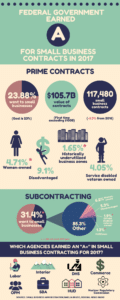
SBA scorecard: Small business contracts exceed $100B for first time ever
The federal government remains on a hot streak in meeting its small business contracting goals.
Best listening experience is on Chrome, Firefox or Safari. Subscribe to Federal Drive’s daily audio interviews on Apple Podcasts or PodcastOne.
The federal government remains on a hot streak in meeting its small business contracting goals.
For the fifth year in a row, it exceeded its governmentwide small business contracting goal — about 23 percent of its contracting spending.
In the release of its scorecard for fiscal 2017, the Small Business Administration gave the federal government an overall ‘A’ grade. Fiscal 2017 also marked the first year that small business contracted exceeded $100 billion in the federal government.
Eight agencies earned the highest mark, an A-plus: The departments of Homeland Security, Commerce, Labor, Interior, Housing and Urban Development, the Office of Personnel Management, Nuclear Regulatory Commission and SBA.
 In a conference call with reporters on Tuesday, Kenneth Dodds, SBA’s director of policy, planning and liaison, said not much has changed with the list of top agencies.
In a conference call with reporters on Tuesday, Kenneth Dodds, SBA’s director of policy, planning and liaison, said not much has changed with the list of top agencies.
“Those agencies have very good, strong [Offices of Small & Disadvantaged Business Utilization] that have great strategies in terms of participating with upper leadership and getting the buy-in for small business — and have procedures in place to make sure that they’re reviewing things and things are going to small business that should be going to small business,” Dodds said.
The top-performing agencies set high benchmarks for their small business sectors. SBA, for example, has a goal of over 72 percent. The Interior Department set its FY 2017 goal just over 53 percent.
SBA administrator Linda McMahon gave the public sneak peek of the scorecard results last week when she spoke at the National Press Club.
“This grade reflects significant efforts by federal agencies toward meeting the 23 percent statutory goal to award prime contracts to small businesses. Every contract that gets in the hands of a small business owner is a win-win for the business, creating jobs in their communities, and boosting the nation’s economy,” SBA Administrator Linda McMahon said in a statement Tuesday.
The federal government missed the mark on its governmentwide prime contracting goal for women-owned small businesses, aiming for 5 percent, but only getting about 4.71 percent last fiscal year.
It also missed the mark on its prime and subcontracting goals for Historically Underutilized Business Zones (HUBZones).
The federal government also just barely missed its small business subcontracting goal for FY 2017.
However, the federal government did exceed its subcontracting goal for women-owned small business. The same goes for subcontracting with small disadvantaged businesses, and service-disabled-veteran-owned small businesses.
This year, the SBA made some changes to the scorecard’s rubric, due to a provision in the 2016 National Defense Authorization Act.
Those changes reduced the importance of prime contracting on the scorecard, bringing its weight on the overall letter grade down from 80 percent to 50 percent.
Meanwhile, subcontracting went up in importance, going from 10 percent to 20 percent of the final score.
Another 20 percent was based on compliance with Office of Small & Disadvantaged Business Utilization (OSDBU) requirements.
The final 10 percent was based on a change in the number of small business contracts. The overall score improved or went down based on how many small business contracts were made in FY 2017 compared to the previous year.
Thanks to a recent law change, the map used for HUBZone businesses will remain unchanged until 2020. Going forward, Dodds said the map will now change every five years instead of every year.
But SBA is working on a proposed rule it says would make HUBZone requirements less burdensome and easier to comply with.
“The rules were kind of written much stricter and much different than all of our other programs, and I think that we need to reduce the burden on small business to make them as uniform as possible,” Dodds said, adding that the proposed rule should come out sometime this summer.
Reaching out to small business tech
SBA included small business participation for the first time in the latest scorecard. But the agency doesn’t anticipate any changes to the small business scorecard from his end of things.
However, the Section 809 Panel, an acquisition regulations advisory group, has some concerns about the state of the Defense Department’s small business contracting.
Earlier this year, it found that the number of DoD small business actions has gone down by almost 70 percent since FY 2011, even though dollar amount for small business contracting is going up.
The Section 809 Panel has recommended that DoD, which earned an A on its scorecard, make its small business contracting more strategic to include more IT companies.
Dodds said SBA has talked with the Section 809 panel about making DoD’s small business contracting more strategic.
“There are small businesses out there that have great technology and innovation that don’t want to deal with the government and don’t want to sell to DoD because it’s so complicated. It certainly makes sense to reach out to them and get them involved,” Dodds said.
Copyright © 2025 Federal News Network. All rights reserved. This website is not intended for users located within the European Economic Area.
Jory Heckman is a reporter at Federal News Network covering U.S. Postal Service, IRS, big data and technology issues.
Follow @jheckmanWFED
Related Stories





